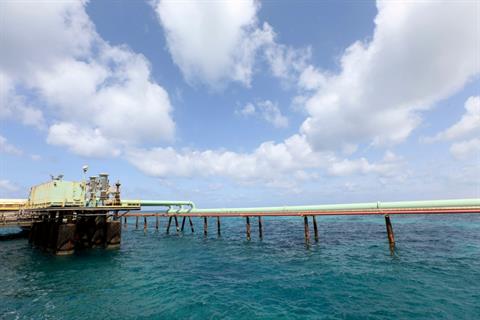Libya’s parliament approved the overdue 2014 budget worth $47 billion Sunday, drawing on reserves to offset a dramatic loss of oil revenue after almost a year of protests at major ports.
The North African country is in turmoil as the government struggles to control militias who helped oust Moammar Gadhafi in 2011 but now defy the state and seize oil facilities.
Almost a year of protests at the oil fields and ports have reduced oil output to a fraction to the 1.4 million bpd it was in July when the strikes started.
Parliamentary spokesman Omar Hmeidan said lawmakers approved the 56.5 billion Libyan dinars ($47 billion) budget submitted by the government in January.
The delay had been caused by MPs trying to trim spending. However, cutting the budget is difficult as more than half of it goes on subsidies and salaries for an overstaffed and inefficient public service, a legacy of Gadhafi, who put most adults on the payroll to discourage opposition.
The government put pressure on lawmakers to approve the budget by saying last week it would start using it after the legal limit for debate had been exhausted.
It will be largely funded by drawing on surpluses worth 8 billion dinars, a central bank reserve fund of 16 billion dinars – originally intended as a buffer for future generations – plus 26 billion dinars in oil revenue, said Mohammad Abdullah, head of the budget committee.
Oil revenue typically makes up 95 percent of the budget in the absence of a sizable non-oil industry. However, relying on oil revenue of 26 billion dinars sounds optimistic as Libya only made 4 billion in the first four months of the year, a quarter of what it usually makes.
While Libya’s eastern Hariga oil port reopened Sunday and the western Al-Feel oil field ramped up output, lifting national production to 270,000 barrels a day, the central bank could be forced to dip into its foreign reserves to fund the budget.
The budget committee based the budget for 2014 on an annual oil production of 600,000 bpd.
The central bank holds around $110 billion in foreign reserves but only part of the money is cash, with the rest held in overseas bonds, deposits or equity stakes.
The draft is smaller than the 2013 budget worth 66.8 billion dinars.
National Oil Corp. said Hariga port received a first tanker loading 750,000 barrels of oil Saturday and a second was expected Sunday to load 600,000 barrels of oil.
Hariga had been closed for a month by members of the state Petroleum Facilities Guards who said they had not been paid for months, one of the many disruptions caused by militias, state security guards and tribesmen at oil facilities.
Omar Zwei, spokesman for Arabian Gulf Oil Co operating the port, said the oil guards had allowed the docking only as a goodwill gesture after receiving their delayed salaries for March and April.
“There is another tanker waiting to load but there are discussions ongoing with the PFG to allow the tanker to start loading because they have not received their May salaries yet,” he said.
NOC spokesman Mohammad al-Harari also said the western Al-Feel oilfield, operated by NOC and Italy’s ENI, was producing 95,000 bpd. This would lift national output to 270,000 bpd, he said. Output had fallen to 100,000 bpd this month.
The NOC spokesman also said there were efforts under way to reopen the 340,000-bpd southwestern Al-Sharara field. Protesters at the field and connecting pipeline have blocked production several times since October.
Last year, rebels seized Hariga and three other eastern ports with the aim of exporting crude oil from there themselves.
It took the government until April to reach an agreement with them to relinquish Hariga and Zueitina port and to restart exports, only for Hariga to be closed again last month.
The rebels have kept shut the larger Ras Lanuf and Es Sider ports pending further talks with the government. A fourth eastern port, Zueitina, is technically open but there is currently no crude to load.



